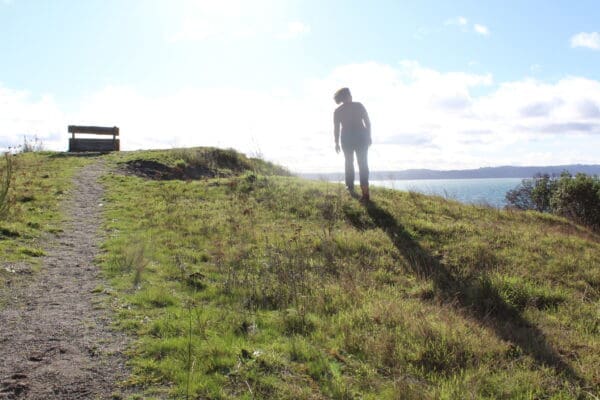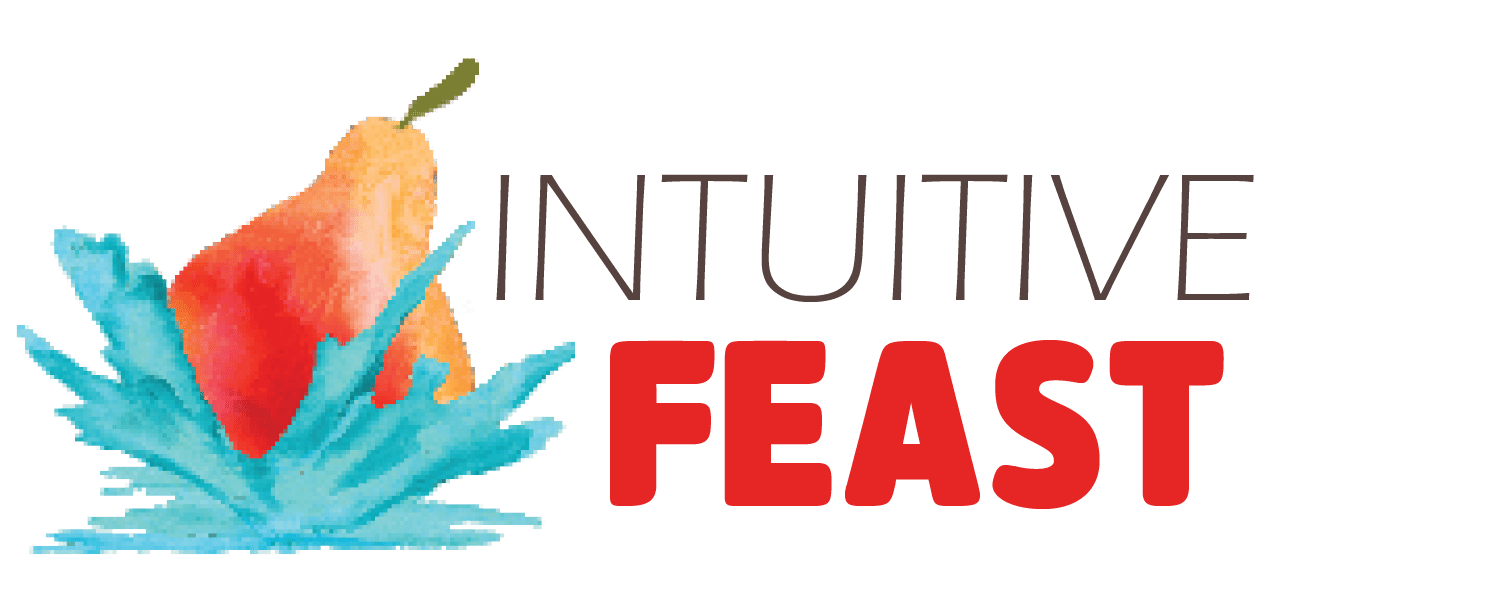Grief. As the sun fades and winter’s darkness approaches, it can feel everywhere these days: grief for the people and beliefs we have lost, grief for our own aging bodies, even just grief for the falling leaves, the grief of change. Change, even good change, is always a loss of something, and acknowledging that loss allows us to acknowledge the full spectrum of our human experience, the natural cycle of intertwined suffering and joy. Grief is weighty, grief is dark. But learning to allow for grief in the same way we allow for pleasure is the root of resilience.
What do I mean when I say allow for grief, and how does grief surface as we navigate the world of food and body healing?
Today, in this two part series, we’re going to focus on the grief of body changes. (Read Part 2 here). One of the more obvious places grief arises in food and body healing is the grief of letting go of the thin ideal. As we allow our bodies to settle at the size that is right for them, we may notice that this size is larger than what we have been led to believe is ok.
From childhood, most of us have been inoculated with the poisonous fiction that only a thin body can be happy, healthy, or loved. Life experiences that might suggest otherwise are often overridden by a torrent of negative cultural messaging towards bigger bodies, which develops into internalized weight stigma. At first, as we let go of dieting restrictions and try to eat when we are hungry, and move when it feels good, it can be an attractive bargain to imagine that this intuitive eating and movement will result in weight loss. After all, if eating when we are hungry is a healthy action, and health = thinness, shouldn’t this action eventually result in thinness? But over time, as we open ourselves up to a paradigm change in ideas, and begin to challenge the lies the diet industry has sold us, a crack begins to open between health and thinness. What if these don’t have to be the same thing? After all, the human race has incredible genetic diversity. Many of us had our DNA forged in environments where it was protective to have more insulating fat, or a bigger bone structure for lifting and carrying. Left alone and appropriately fed, our bodies will usually become a well-nourished version of our genetic set-point.
But accepting this reality isn’t just about accepting the different ways it feels to move and live in a larger body, or letting go of dieting thoughts and behaviors. It is also about letting go of a dream implanted in us from an early age: that if we could reach that vision of the thin ideal, everything would be fixed. If our weight isn’t the cause of all the wrongness and badness in our lives, then what is? And what if wrongness and badness are an inescapable part of life?
That’s a really hard concept to sit with. It brings up all the feelings associated with grief: denial, anger, bargaining, depression. It isn’t something that passes over us like a quick dark cloud. Instead, it can feel like a fog, a thick grey settled around us on all sides.
It can be especially difficult with pain. So often, we are (erroneously) told by medical professionals that our musculoskeletal pain can be attributed to our weight. It is comforting to believe that all the pain could go away, if only the number on the scale dropped low enough. But the relationship between pain and weight isn’t so black and white. (Thin people also have pain). We often do gain weight at the same time as we are experiencing increasing pain, but is weight the cause of pain, or vice versa? Most people become more sedentary as their pain increases, and most of us fill out to the higher end of our set-point (which is a range, not a single number) when we are more sedentary. When the atmosphere above us is subjecting every inch of our body to nearly 15 pounds of pressure every second, and our force-bearing joints are made to withstand many times our body weight when we run or jump, does a few pounds of fat really make a difference? This is especially important to consider given that fat can exert helpful pressure on our bones to stay stronger as we age: thinner bodies are more prone to osteoporosis with time.
Sometimes letting go of the distraction of focusing on weight allows us to find an underlying cause that actually can fix, or greatly alleviate, our pain. But sometimes not. With pain and unhappiness both, sometimes these things are just an inescapable part of living in the body (and life) we have. It may be necessary to grieve the idea that they would ever leave us, the idea that we could live in a world of endless summer, and we must settle into seasons of suffering and the constancy of change.
To explore all the ways we learn to live with grief and pain would take an entire book (and a psychology degree), but in both cases trying to challenge faulty assumptions and notice and allow for the feelings that come up can help. Much has been written about how grief isn’t a tidy stage by stage process, but the concepts of bargaining, anger, denial, depression, and acceptance can be helpful when thinking about how to grieve the thin ideal.

To start,
consider allowing for negative feelings to arise. Anger and sadness are natural pieces of the human experience, and when we just sit and allow those feelings to wash over us, like a wave, we can improve our ability to tolerate them. Remember to direct anger outward, (to society’s toxic messages and systems), rather than inward (as guilt or shame). Nothing about this is your fault! The thin ideal is a thought virus of impossible ideals that has circulated for decades in Western Culture. Catching it was unavoidable, and that should make you furious!
As you attend to your thoughts and feelings, notice the different pieces of this story that you need to grieve. Grief for the time and happiness wasted on dieting and obsessing over food. Grief for the things you might have disallowed yourself, awaiting a thinner day. Grief for how difficult our ableist world makes it for larger-bodied people to find chairs, sports equipment, airplanes, and surgery tables that fit. (Also not your fault: there is no reason except prejudice that these things couldn’t be made bigger and stronger to accommodate more people!) And finally, the biggest, hardest grief any of us will ever face: for the fact that some pains and debility, including, ultimately, death, are natural and inescapable parts of the human experience.
It’s a lot of feels to feel. Take your time. It is absolutely ok to take feelings in small pieces and work up as you increase your distress tolerance. Distractions (like talking to a friend or watching a favorite TV show) can help us cope when we need to take a break from being directly with feelings. Anger is an energetic emotion: it can often help to release through movement: screaming, punching, walking, breaking. Once you are ready, activism to fight weight stigma in the wider world can be a great outlet for anger. Depression is quieter: journaling is a great way to release sadness onto the page, as is talking to and forming community with other people in the same situation. You are definitely not alone nor are you the first explorer in this strange new land of fat-is-ok. Support groups and online communities can offer mentorship and understanding, and of course, individual mental health therapy is a critical part of moving through your own unique journey for this and any type of grief.
As you begin to notice and name your emotions, notice also the different ways you cope with and distract from emotions. Try not to judge your coping strategies, including, possibly, food. Just notice. Eating triggers feel-good neurotransmitters in the brain. This is natural and normal: for most of us, eating (such as drinking milk at our mother’s breast) is the first way we learn to cope with distress and uncertainty. Eating (in this context) is just another form of distraction. It doesn’t advance our distress tolerance, but all distractions can give us a needed break when we are tired of feelings surfing. Just notice when distracting with food is most helpful, when other distractions help more, and the times you are feeling versus distracting, so that you can have more choice in the process overall.
All throughout this journey, thoughts of denial and bargaining will arise. Thoughts that perhaps you could diet just one last time, or just a little bit. This is normal. Any healing journey is up and down. Rather than completely push these thoughts away, try and explore the suggested possibilities to their conclusion. What if you did diet “one last time?” What is the most likely outcome? And then what would you do? And then what? Often this fuller examination will help you to see the danger lurking at the end of the road and reconnect you to your motivation to break up with diet culture forever. Continue to exposure yourself to paradigm-changing information. The lies of diet culture will arise again and again in media, television, and the comments of those around you. Continuous exposure to the antidote: myth-busting books, resources, and carefully curated social media, will help keep the lies from sticking.
As you open yourself to the grief of losing the thin ideal, you’ll notice that the fog around you begins to shift, become more translucent. Like the gray mists of morning, the fog will return again, but pushing in and outward, thinning and thickening, rather than all-encompassing and constant. Like a change in seasons or a shift in weather, sadness, suffering and darkness are an important part of what it means to be human. Suffering hurts, but its existence doesn’t preclude simultaneous experiences of joy. For me, it feels like walking around made of layers. Cut me open, and there’s glitter and sunlight (excitement and joy) wedged in-between fire and black water (anger and despair). At the core of everything is the black pool where my grief will always live, but its gravity tethers me to the earth.
When we stop questioning the validity of our suffering and pain, when we stop fighting that it has a right to be a part of our story, our quality of life and strength of resilience can change dramatically. We have to suffer to exist, but we don’t have to suffer because of our suffering. Living life in a bigger body than we planned or were promised isn’t necessarily going to be easy or always awesome, but it can be ok.

